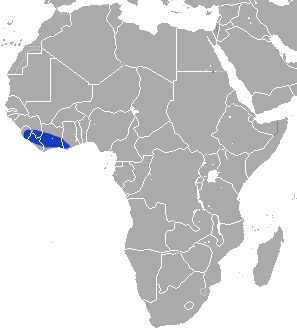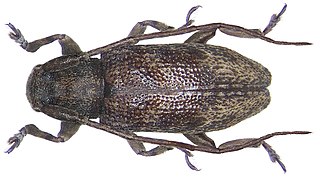
The Afghan snowfinch or the Afghan ground-sparrow, bar-tailed snowfinch, Meinertzhagen's snowfinch, or Theresa's snowfinch, is a passerine bird of the sparrow family Passeridae, endemic to the northern parts of the Hindu Kush mountains in Afghanistan. There are no major threats to the species despite its restricted range, so it is assessed as least concern on the IUCN Red List. This species is mostly a seed-eater, supplementing its diet with some insects. It builds its nest in the burrows or hollows of ground-dwelling rodents, lined with hair or feathers.

Therese's shrew is a species of mammal in the family Soricidae. It is found in Ivory Coast, Ghana, Guinea, Liberia, and Sierra Leone. Its natural habitats are subtropical or tropical moist lowland forest and moist savanna.

Ropica Górna is a village in the administrative district of Gmina Sękowa, within Gorlice County, Lesser Poland Voivodeship, in southern Poland, close to the border with Slovakia. It lies approximately 4 kilometres (2 mi) east of Sękowa, 9 km (6 mi) south-east of Gorlice, and 108 km (67 mi) south-east of the regional capital Kraków.

Quekettia is a small genus of orchids classified in the subtribe Oncidiinae. This genus is found in the humid lowlands of Brazil, the Guianas, Venezuela, Ecuador and Trinidad.
Tanganya virus(TGNV) is an enveloped, single-stranded, negative-sense RNA virus, possibly of the genus orthohantavirus in the Bunyavirales order. It is the second indigenous Murinae-associated African hantavirus to be discovered. It has a low sequence similarity to other hantaviruses and serologically distinct from other hantaviruses. Its host is Crocidura theresae.

Ropica is a genus of beetles in the family Cerambycidae, containing the following species:
Ropica marmorata is a species of beetle in the family Cerambycidae. It was described by Breuning in 1939. It contains the subspecies Ropica marmorata marmorata and Ropica marmorata sarawakiana.
Ropica granuliscapa is a species of beetle in the family Cerambycidae. It was described by Breuning in 1942.
Ropica rosti is a species of beetle in the family Cerambycidae. It was described by Breuning in 1958.
Ropica sechellarum is a species of beetle in the family Cerambycidae. It was described by Breuning in 1957. It contains the subspecies Ropica sechellarum interruptefasciata and Ropica sechellarum sechellarum.

Ropica rufonotata is a species of beetle in the family Cerambycidae. It was described by Pic in 1926.

Ropica indigna is a species of beetle in the family Cerambycidae. It was described by Pascoe in 1865.
Ropica formosana is a species of beetle in the family Cerambycidae. It was described by Henry Walter Bates in 1866. It contains four subspecies, Ropica formosana formosana, Ropica formosana japonica, Ropica formosana nobuoi, and Ropica formosana tokaraensis.
Cassinia theresae is a species of flowering plant in the family Asteraceae and is endemic to central New South Wales. It is an erect shrub with hairy young stems, needle-shaped leaves with flared bases, and corymbs of up to fifty flower heads.
Eunidia theresae is a species of beetle in the family Cerambycidae. It was described by Stephan von Breuning in 1939.
Falsomesosella theresae is a species of beetle in the family Cerambycidae. It was described by Maurice Pic in 1945.
Pterolophia theresae is a species of beetle in the family Cerambycidae. It was described by Maurice Pic in 1944.
Mallosia theresae is a species of beetle in the family Cerambycidae. It was described by Maurice Pic in 1900. It is endemic to Turkey.
Laevipilina theresae is a species of monoplacophoran, a superficially limpet-like marine mollusk. It is known from a live specimen collected in the Eastern Weddell Sea of Antarctica.

Cochemiea theresae is a species of cactus in the subfamily Cactoideae.






